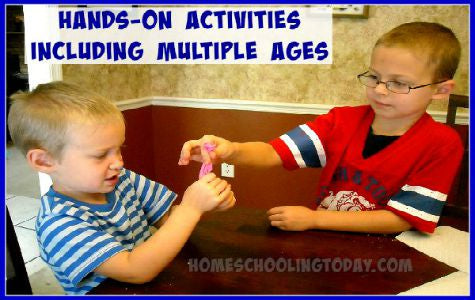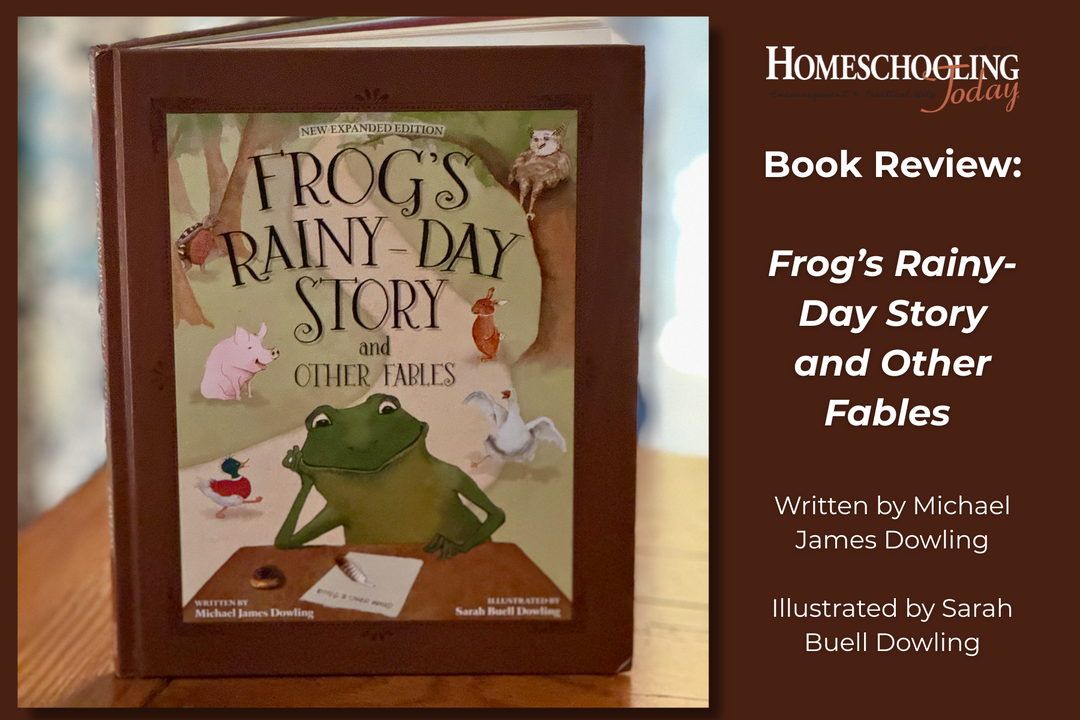Hands-On Activities For Multiple Ages

Welcome to the hands-on learning series by Stef Layton, where she answers questions she’s received about tactile learners. Do you have a hands-on learner? These posts will give you great insight, advice, and practical application tips. Enjoy!
We have a saying in our home,"A good leader includes everyone."But after homeschooling a 4 & 1/2 year age gap ... I have come to realize not "everyone" is always ready to be included. Thankfully, we have found a few ways for our boys to work together.
 Expect Different Results.Age, fine motor skills, and a different learning styles will all play a role when many hands come to the table. Do not have the same expectation for each child. My youngest son is not as tactile as his older brother, so he does not require as much hands-on reinforcement. Yet I still want him to enjoy the activities, but I expect completely different results.
Focus on the Tactile Learner. Hands-on activities should be geared toward the hands-on learners. Naturally an auditory learner will not be half as interested in the hands-on activity. It might be fun or them, but they will not put in half the detail as a hands-on learner would give. Allow everyone to participate but spend your focus on the hands-on learner.
Offer Different Supplies. When I set up a hands-on activity I would have one pile of supplies for my older tactile son and one pile of age-appropriate supplies for my younger auditory son. When we built a jungle diorama my tactile learner would draw each animal, cut them out, and meticulously place them into the box. My younger son would need a jungle coloring page, help cutting, and then would slap the wild cats up in the sky.
Let Them Watch. I once taught a zoology science co-op. The day I busted out owl pellets the hands-on learners dived into the pile of silver wrapped surprises. The other children who were visual learners were just as happy to watch what was being discovered. Even when I urged them to try, they were not having any of it. I felt a bit discouraged until the parents arrived and those nonparticipants were hopping about sharing what happened that day. I realized they were participating in their own learning style, watching.
Hands-on activities are fun, but never forget that a tactile learner will be the one to truly benefit from them. Otherwise, the project is just a craft to other learners.
Obviously I am all for hands-on learning, but be sure to incorporate auditory activities, visual opportunities, and kinesthetic gross motor fun. You might be surprised one day when your child sings the 50 States and you hadn't made one salt dough map.
My boys love to work together on hands-on projects. One might spend more time and detail than the other, yet I know the ability to work well with another person is the gift.
****************************************
Expect Different Results.Age, fine motor skills, and a different learning styles will all play a role when many hands come to the table. Do not have the same expectation for each child. My youngest son is not as tactile as his older brother, so he does not require as much hands-on reinforcement. Yet I still want him to enjoy the activities, but I expect completely different results.
Focus on the Tactile Learner. Hands-on activities should be geared toward the hands-on learners. Naturally an auditory learner will not be half as interested in the hands-on activity. It might be fun or them, but they will not put in half the detail as a hands-on learner would give. Allow everyone to participate but spend your focus on the hands-on learner.
Offer Different Supplies. When I set up a hands-on activity I would have one pile of supplies for my older tactile son and one pile of age-appropriate supplies for my younger auditory son. When we built a jungle diorama my tactile learner would draw each animal, cut them out, and meticulously place them into the box. My younger son would need a jungle coloring page, help cutting, and then would slap the wild cats up in the sky.
Let Them Watch. I once taught a zoology science co-op. The day I busted out owl pellets the hands-on learners dived into the pile of silver wrapped surprises. The other children who were visual learners were just as happy to watch what was being discovered. Even when I urged them to try, they were not having any of it. I felt a bit discouraged until the parents arrived and those nonparticipants were hopping about sharing what happened that day. I realized they were participating in their own learning style, watching.
Hands-on activities are fun, but never forget that a tactile learner will be the one to truly benefit from them. Otherwise, the project is just a craft to other learners.
Obviously I am all for hands-on learning, but be sure to incorporate auditory activities, visual opportunities, and kinesthetic gross motor fun. You might be surprised one day when your child sings the 50 States and you hadn't made one salt dough map.
My boys love to work together on hands-on projects. One might spend more time and detail than the other, yet I know the ability to work well with another person is the gift.
****************************************
 Expect Different Results.Age, fine motor skills, and a different learning styles will all play a role when many hands come to the table. Do not have the same expectation for each child. My youngest son is not as tactile as his older brother, so he does not require as much hands-on reinforcement. Yet I still want him to enjoy the activities, but I expect completely different results.
Focus on the Tactile Learner. Hands-on activities should be geared toward the hands-on learners. Naturally an auditory learner will not be half as interested in the hands-on activity. It might be fun or them, but they will not put in half the detail as a hands-on learner would give. Allow everyone to participate but spend your focus on the hands-on learner.
Offer Different Supplies. When I set up a hands-on activity I would have one pile of supplies for my older tactile son and one pile of age-appropriate supplies for my younger auditory son. When we built a jungle diorama my tactile learner would draw each animal, cut them out, and meticulously place them into the box. My younger son would need a jungle coloring page, help cutting, and then would slap the wild cats up in the sky.
Let Them Watch. I once taught a zoology science co-op. The day I busted out owl pellets the hands-on learners dived into the pile of silver wrapped surprises. The other children who were visual learners were just as happy to watch what was being discovered. Even when I urged them to try, they were not having any of it. I felt a bit discouraged until the parents arrived and those nonparticipants were hopping about sharing what happened that day. I realized they were participating in their own learning style, watching.
Hands-on activities are fun, but never forget that a tactile learner will be the one to truly benefit from them. Otherwise, the project is just a craft to other learners.
Obviously I am all for hands-on learning, but be sure to incorporate auditory activities, visual opportunities, and kinesthetic gross motor fun. You might be surprised one day when your child sings the 50 States and you hadn't made one salt dough map.
My boys love to work together on hands-on projects. One might spend more time and detail than the other, yet I know the ability to work well with another person is the gift.
****************************************
Expect Different Results.Age, fine motor skills, and a different learning styles will all play a role when many hands come to the table. Do not have the same expectation for each child. My youngest son is not as tactile as his older brother, so he does not require as much hands-on reinforcement. Yet I still want him to enjoy the activities, but I expect completely different results.
Focus on the Tactile Learner. Hands-on activities should be geared toward the hands-on learners. Naturally an auditory learner will not be half as interested in the hands-on activity. It might be fun or them, but they will not put in half the detail as a hands-on learner would give. Allow everyone to participate but spend your focus on the hands-on learner.
Offer Different Supplies. When I set up a hands-on activity I would have one pile of supplies for my older tactile son and one pile of age-appropriate supplies for my younger auditory son. When we built a jungle diorama my tactile learner would draw each animal, cut them out, and meticulously place them into the box. My younger son would need a jungle coloring page, help cutting, and then would slap the wild cats up in the sky.
Let Them Watch. I once taught a zoology science co-op. The day I busted out owl pellets the hands-on learners dived into the pile of silver wrapped surprises. The other children who were visual learners were just as happy to watch what was being discovered. Even when I urged them to try, they were not having any of it. I felt a bit discouraged until the parents arrived and those nonparticipants were hopping about sharing what happened that day. I realized they were participating in their own learning style, watching.
Hands-on activities are fun, but never forget that a tactile learner will be the one to truly benefit from them. Otherwise, the project is just a craft to other learners.
Obviously I am all for hands-on learning, but be sure to incorporate auditory activities, visual opportunities, and kinesthetic gross motor fun. You might be surprised one day when your child sings the 50 States and you hadn't made one salt dough map.
My boys love to work together on hands-on projects. One might spend more time and detail than the other, yet I know the ability to work well with another person is the gift.
****************************************
Stef Layton lives in Orlando, Florida homeschooling two tactile learners. Stef is the Hands-On Learning Columnist for Homeschooling Today magazine. This year she started showing hands-on activities on youtube. You can follow her on Instagram or Twitter @StefMLayton.











